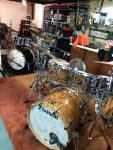Cmdr. Ross
Platinum Member
Finally someone with sense when it comes to drum construction and the sound produced by the heads not the shell. I agree wholeheartedly with your assessment of shell thickness and wood versus metal. One major, major point is.....Roto Toms. There is no shell and they can sound great. I found a set of CB 700s sitting by a dumpster waiting for the garbage man. I took them home, stripped the crappy wrap, stained the Luan plies, put good Remo Ambassadors all around and those drums sounded great.
Damn, that's great work. Great minds think alike!
My drumsmithing "career" started like this. Buying shit-kits from people for next to nothing & using woodworking skills to give them new life. Sometimes it was in the form of a cocktail kit, or short depth fusion kit. Other times it was like what you did here. Just make them look & sound good.
The possibilities are endless.


